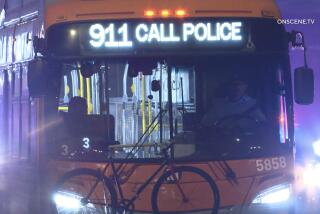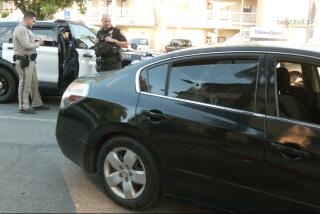Too Much Ado About Freeway Shootings? : A Made-for-L.A. Story, but Stop-the-Presses Attention Seems Excessive
Welcome to a quick multiple-choice quiz in Journalism 101, the possible answers drawn from a several-day period in June best remembered as a week of Miami in Los Angeles.
Which of these three stories from that period would have the broadest appeal to Southern California news readers/viewers/listeners?
(1) A gang member opens fire on a church-sponsored anti-gang rally in Pomona. Four persons are wounded.
(2) Gunmen steal the district attorney’s car and abduct his driver outside a fancy Hollywood restaurant. The driver is released unharmed.
(3) A frustrated motorist opens fire and kills a passenger in a car that slows down in the fast lane of a freeway. It is the third freeway shooting--and the second death--in a year.
The clear winner: The freeway shooting.
Gang members have escalated violence to an appalling level, but they tend to operate in tightly circumscribed areas and have little effect on the broad population. The theft of the district attorney’s car is a novel story, but he represents only a portion of Southern California and, besides, he wasn’t even in the car.
But a shooting on a freeway? That satisfies a basic demand of journalism. The freeways are one of the few common denominators in Southern California. Everyone uses them. They are shared experiences. We all have a vested interest in the safety of that aspect of our lives. And when an editor can strike such a responsive chord with a single story, he or she goes for it.
You see, this is really a tough place to be in the news business (though a marvelous place to be selling advertising). Southern California has no vital center. With its governmental, economic, ethnic and social fragmentation, there are few themes or stories or personalities that command the general public’s continuing attention. People don’t identify with the city as they do, say, in Chicago or New York. Politics around here are defused and tepid. People are more into life style and work than they are into community. Broadcast stations and newspapers that attempt to service the whole region with news are always pressed for stories of universal interest. The freeway shootings easily meet that requirement.
In late June, with the three shootings and two deaths beneath our collective belts, a Los Angeles Times contributor (me) began a column by writing: “We are beginning to sense the sound of gunfire above the roar of the freeways.” The story was reflective not of personal clairvoyance but of a desire to seize on a trendoid--the journalistic category reflecting something new, potentially interesting and possibly --just possibly--indicative of trend.
The trendoid has developed into a reality. On Thursday a local paper increased its freeway-shooting count from 12 to 15 between editions. A regional police task force on freeway shootings is now in operation. Los Angeles motorcycle policemen are urged to wear bulletproof vests. People who live along freeways worry about ricocheting bullets. Freeway shootings have replaced pit bulls, Oliver North, Joan Collins and Sean Penn as the topic of conversation at the water cooler.
Goodness knows that the media haven’t shied from the topic because of some chauvinistic spirit. Headlines have been blunt. Gravely concerned TV news reporters advance the story from freeway overpasses or in police auto pounds before vehicles with bullet-shattered windshields. Radio stations interview “dial-a-psychologists” who provide instant analyses of anonymous gunmen.
But for all the breathless urgency inherent to this cascading coverage, are we--the meek, unarmed, good-citizen drivers of the freeways--really in danger? One waits for some reporter to figure out the daily number of freeway trips and compare that with the number of shootings. Are we now at greater risk on the freeways, say, than we are buying a six-pack in a convenience store at 11 p.m. or drawing cash from an automated teller machine on a seemingly deserted street? How many lifetimes would one have to live in Los Angeles, traveling on the freeways several times a week, before entering a statistical zone of susceptibility to a freeway shooter?
Yes, the freeway shootings are ghastly for the victims and their families. They are temporarily devastating to an implied trust in the good will of our fellow man. And community outrage and police determination are imperative to discouraging the copycat shooters.
But one suspects that the actual menace falls far short of that implied in the headlines and the broadcast reports.
We have been thoroughly advised of the problem, in all its grim manifestations. With the assistance of the news media we have discovered in the random violence a true linkage, something that we can all share. But the question is: Should we be sharing it to the degree that we are?
More to Read
Sign up for Essential California
The most important California stories and recommendations in your inbox every morning.
You may occasionally receive promotional content from the Los Angeles Times.










